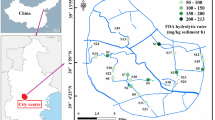Abstract
This study adapted the bulk fluorescein diacetate (FDA) assay to evaluate the impact of crude oil on biological activity levels in marine sediments. Sediment cores from the Elkhorn Slough, California were incubated with different levels of sweet crude oil (Deepwater Horizon, Macondo Prospect) in the Moss landing Marine Laboratories aquarium facility over a 30-day period. During this period, the amount of fluorescein released, concentration of oxygen in overlying waters, and flux of oxygen into the sediments were monitored. For all treatments a strong negative correlation between added oil and FDA production was observed (p < 0.05). The concentration of oxygen in the first 2 mm of sediment cores decreased linearly with the addition of crude oil and correlated positively with fluorescein released (p < 0.05). A linear increase in sediment oxygen flux was also observed upon crude oil addition. The miniaturized bulk FDA assay could be powerful in evaluating oil spill impacts in coastal systems.







Similar content being viewed by others
References
Adam G, Duncan H (2001) Development of a sensitive and rapid method for the measurement of total microbial activity using fluorescein diacetate (FDA) in a range of soils. Soil Biol Biochem 33:943–951
Chand S, Lusunzi L, Veal DA, Williams LR, Karuso P (1994) Rapid screening of the antimicrobial activity of extracts and natural products. J Antibiot 47:1295–1304
Chrzanowski TH, Crotty RD, Hubbard JG, Welch RP (1984) Applicability of the fluorescein diacetate method of detecting active bacteria in freshwater. Microb Ecol 10:179–185
Clarke JM, Gillings MR, Altavilla N, Beattie AJ (2001) Potential problems with fluorescein diacetate assays of cell viability when testing natural products for antimicrobial activity. J Microbiol Methods 4:261–267
Elarbaoui S, Richard M, Boufahja F, Mahmoudi E, Thomas-Guyon H (2015) Effect of crude oil exposure and dispersant application on meiofauna: an intertidal mesocosm experiment. Environ Sci Process Impacts 17(5):997–1004
GESAMP (1993) Reports and studies No. 50, IMO/FAO/UNESCO/WMO/WHO/IAEA/UN joint Group of experts on the scientific aspects of marine contamination
Guilbaut GG, Kramer DN (1966) Lipolysis of fluorescein and eosin esters: kinetics of hydrolysis. Anal Biochem 14:28–40
Gumprecht R, Gerlach H, Nehrkorn A (1995) FDA hydrolysis and resazurin reduction as a measure of microbial activity in sediments from the south-east Atlantic. Helgolander Meeresunters 49:189–199
Hallock P, Lidz BH, Cockey-Burkhard EM, Donnelly KB (2003) Foraminifera as bioindicators in coral reef assessment and monitoring: the foram index. Environ Monit Assess 81:221–238, 2003
Jochem FJ (1999) Dark survival strategies in marine phytoplankton assessed by cytometric measurement of metabolic activity with fluorescein diacetate. Mar Biol 135:721–728
Karadede-Akin H, Ünlü E (2007) Heavy metal concentrations in water, sediment, fish and some benthic organisms from Tigris River, Turkey. Environ Monit Assess 131:323–337
Koster M, Jensen P, Meyer-Reil LA (1991) Hydrolytic activities of organisms and biogenic structures in deep-sea sediments. In: Chrost RJ (ed) Microbial enzymes in aquatic environments. Springer, New York, pp 298–310
Libes S (2009) Introduction to marine biogeochemistry, 2nd edn. Academic, London, p 928
Lin Q, Mendelssohn IA (2012) Impacts and recovery of the Deepwater Horizon oil spill on vegetation structure and function of coastal salt marshes in the Northern Gulf of Mexico. Environ Sci Technol 46:3737–3743
Maurer BN (2013) Optimization and characterization of the bulk FDA viability assay to quantify living planktonic biomass. M.S. Thesis. Moss Landing Marine Laboratories, California State University, Monterey Bay
OPEC (2017) Monthly oil market report 2017. http://www.opec.org/opec_web/en/publications/4054.htm. Accessed 1 May 2018
Rotman B, Papermaster BW (1966) Membrane properties of living mammalian cells as studied by enzymatic hydrolysis of fluorogenic esters. Proc Natl Acad Sci 55:134–141
Shin WS, Pardue JH, Jackson WA (2000) Oxygen demand and sulfate reduction in petroleum hydrocarbon contaminated salt marsh soils. Water Res 34(4):1345–1353
Stauffert M, Cravo-Laureau C, Jézéquel R, Barantal S, Cuny P, Gilbert F, Cagnon C, Militon C, Amouroux D, Mahdaoui F, Bouyssiere B, Stora G, Merlin FX, Duran R (2013) Impact of oil on bacterial community structure in bioturbated sediments. PLoS One 8(6):e65347. https://doi.org/10.1371/journal.pone.0065347
Talent LG (1985) The occurrence, seasonal distribution, and reproductive condition of elasmobranch fishes in elkhorn slough, california. Calif Fish Game 71:210–219
Wanandy S, Brouwer N, Liu Q, Mahon A, Cork S, Karuso P, Vemulpad S, Jamie J (2005) Optimization of the fluorescein diacetate antibacterial assay. J Microbiol Methods 60(1):21–30
Ward BB (2005) Temporal variability in nitrification rates and related biogeochemical factors in Monterey Bay, California, USA. Mar Ecol Prog Ser 292:97–109
Welschmeyer N, Maurer B (2012) A portable, sensitive plankton viability assay for IMO shipboard ballast water compliance testing. In: Olgun A, Karokoc FT, Haag F (eds) Proceeding of the global R and D forum on compliance monitoring and enforcement: ballast water management systems, pp 128–140
Acknowledgements
The primary author (EM) would like to thank the International Students Exchange Program (ISEP), California State University-Council on Ocean Affairs Science and Technology (COAST Award) and San Jose State University (H. Thomas Harvey Fellowship) for providing financial support for this work. Special thanks go to Julie Kuo of Moss Landing Marine Laboratories, CA for her technical support.
Author information
Authors and Affiliations
Corresponding author
Additional information
Publisher’s Note
Springer Nature remains neutral with regard to jurisdictional claims in published maps and institutional affiliations.
Rights and permissions
About this article
Cite this article
Mahu, E., Moore-Hanaway, J., Maurer, B. et al. The bulk fluorescein diacetate assay (FDA) as a technique for evaluating biotic impacts of crude oil to coastal sediments. Environ Earth Sci 77, 751 (2018). https://doi.org/10.1007/s12665-018-7945-x
Received:
Accepted:
Published:
DOI: https://doi.org/10.1007/s12665-018-7945-x




